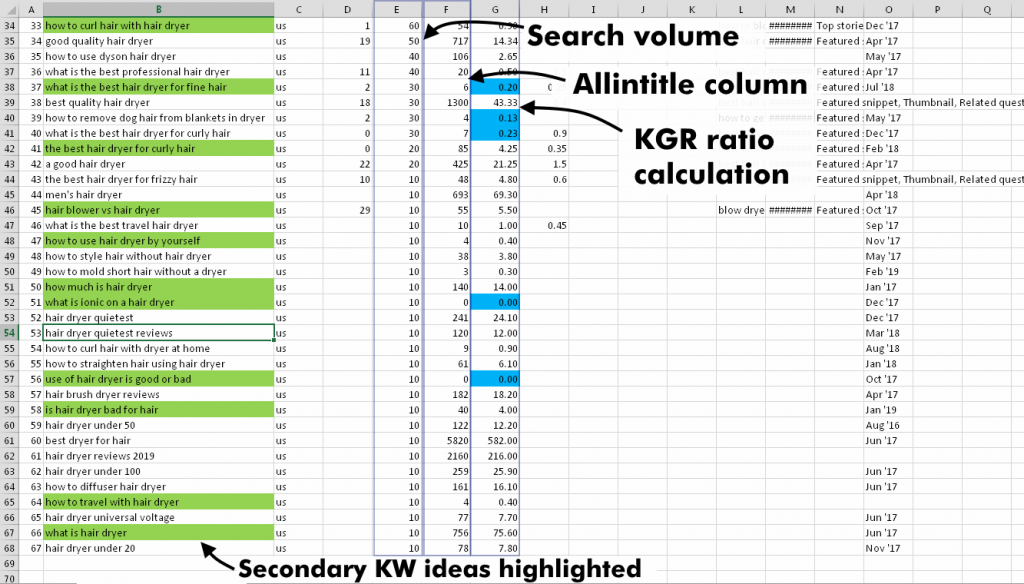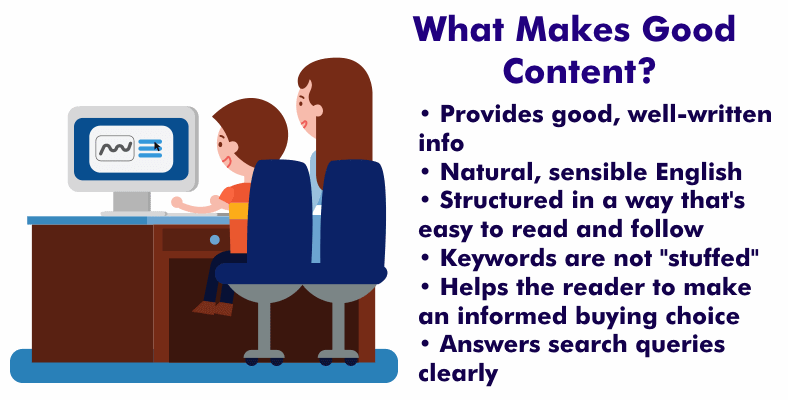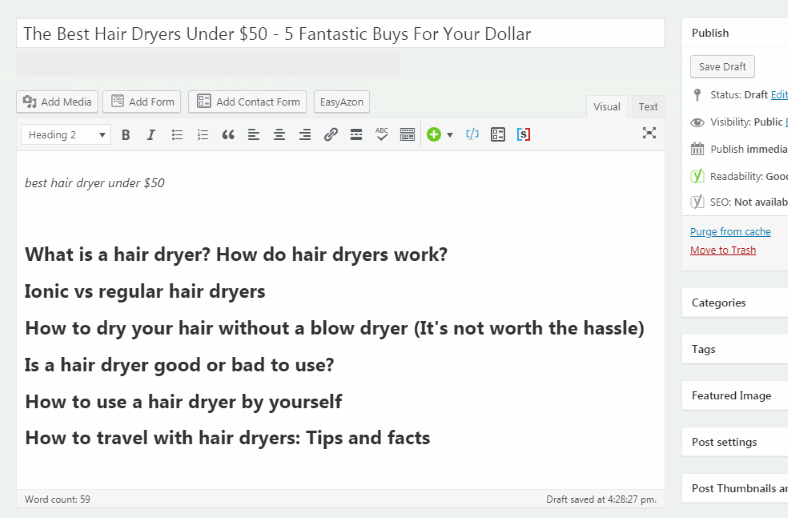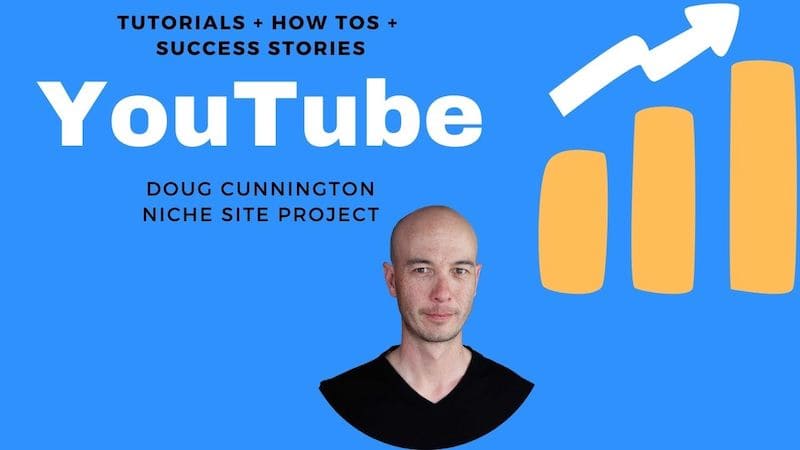This post was written by my friend and Multi Profit Site student, Marty McLeod.
He crushed the $2,000 per month barrier in March 2019, then quit his full time engineering job in Oct 2019. He’s making even more now.
I asked him to share something interesting.
He had some fresh thoughts and actionable tactics about Onpage SEO, Using Secondary Keywords, and Optimizing Keywords.
-Doug Cunnington
When working on keyword-based posts we don’t always think about optimizing them for better results. That’s a shame as there’s a way you can do exactly that with only a little bit of effort.
In fact, you could be losing out on traffic and earnings if you’re not taking advantage of additional keywords you might otherwise never use!
Not only that, but I’ve also discovered my content quality is much better thanks to it, too.
In this article, I’ll share:
- Why you should strategically integrate keywords (that are not the primary target keyword).
- How you can sort through a list of keywords to prioritize and not waste time.
- How to use keywords without forcing it.
- The big picture of delivering value to your visitor.
Secondary Keywords, KGR, and SERPs, oh my!

As members like myself learned in Doug’s great Multi Profit Site course, we use the keyword golden ratio (KGR) approach for keyword research. Ultimately, we use this to help narrow down keyword results to a list of potential main, or focus, low-competition keyword opportunities we’d like to rank for.
For example, “best hair dryer under $50” might be a good fictional example we’d end up with.
Most of the time we’ll write a buyer (or informational) post centered around just that one keyword in both the H1 title as well as a few other locations in the content.
The rest is additional content we’ll need to create not just for the products we’re recommending but to add real value to the reader as well as provide value in Google’s search engine results pages (SERPs).
Secondary Keywords and Keyword Optimization
However, while it’s great to have a focus keyword to aim for, what about that long list of potential keywords we have? Can we use the additional unused keywords as supporting keywords? Not only can we, but it’s a great way to optimize a post for additional SEO value.
That’s because posts don’t rank for only one keyword in Google. In fact, you’d be surprised how many keywords a post can gain traffic for in Google’s eyes.
What we’d like to do is take advantage of that fact and optimize the posts we’re creating with those unused keywords.
Picking Supporting Keywords: An example

Our example keyword list with a lot of keywords, highlighted in green, that will otherwise be wasted. We can use these long tail keywords in our new post for better results.
Following our example keyword research that I mentioned earlier we’ll end up with a fairly long list of keywords we would ordinarily ignore. In fact, a lot of these won’t meet the KGR ratio we use as a guideline, but that’s ok.
The power of this approach is turning seemingly worthless keywords into good secondary ideas and content subtopics.
Sorting through the list
We’ll approach this by doing the following using our keyword (KW) results:
- Look for keywords that make sense in content and are highly relevant (it should make sense to use them, not “keyword stuffing” words in unnaturally)
- Keywords that will work well as subtopics and will give value to the reader
- Keywords that may appear a bit odd in their English but can be tweaked to look better
From the example list in the image above we’ll go through our keywords results and highlight or make notes of those that we consider potential good items to add to our new post’s content.
Don’t force, but tweak and rewrite
When phrases such as “what is hair dryer” and “use of hair dryer is good or bad” appear, don’t fret. They’re still likely great candidates.
It’s important to remember that Google is smart and in most cases your keywords don’t have to be 100% identical matches. That is, for best results we can keep the 2 examples above but will be re-writing them as:
- What is a hair dryer?
- Is a hair dryer good or bad to use?
For good content, you should never stuff (force) keywords with odd English as they’ll appear unnatural and could be a red flag to readers that maybe your content isn’t so good.
Instead, use them with proper English and where relevant. Don’t forcefully “jam” them into content as they are to try to gain an SEO benefit.
I like to use short keywords together at times, too. For example, “What is a hair dryer?” might go well next to “How do they work?” or something similar that I can go into detail about when I write.
The right content approach: It’s not just about SEO

When picking secondary keywords to use and add to a new post, I evaluate them with the following guidelines:
- Does it look like a question or information many people would like an answer to? If it’s close but not quite there, can I rewrite it in a way that will be a good subtopic?
- Can I put this in my content in a way that looks natural and “flows” well within my content?
- If it’s a super-short keyword, would it pair well with another in an H2 subtitle?
- Is this something the competition is not covering well or at all?
If the answer is “yes” to one or more of the criteria above, I highlight it in my spreadsheet and move forward, saving it for writing time.
Additionally, the biggest thing to understand here is that while the goal is to add additional keywords we can rank for, it should be done in a way that looks good and also adds value to the reader.
Good content isn’t only about trying to rank well in Google. To be successful and last longer, it’s very important to put the reader’s best interests in mind. This helps indirectly with things like a reader’s time on the page if it keeps them reading.
Once we have a list of secondary keywords that look like good candidates it’s time to move forward.
Getting your “draft” keywords going

Getting started writing optimized content: 1. Place your secondary keywords (the “raw” keyword phrases) out of your list into the editor or whatever format you use for a draft. 2. Arrange in a logical order and 3. tweak, re-write, and improve them as needed.
With a list of keywords that we can use to optimize our post and drive more search results we’ve got a great list of subtopic ideas. I generally use these mainly for H2 subtitles. At times, however, it may make better sense in an H3 subtitle instead.
The next step is to begin using them in our content. When doing so you’ll see how it’s just a matter of adding them in a way that fits the content structure we want and tweaking the keyword phrases as needed.
To begin, just copy your supporting keywords and paste them into the WordPress editor as I like to do or whatever editor you’re using.
Tweak, write, and enjoy!

Once we’ve tweaked our secondary keywords a bit we’re ready to get started writing our new post! Notice how unnatural English phrases have been fixed to appear correct, they’ve been rearranged, and they’re already set up in such a way that we’ll get a lot of good content ideas for free.
Once we’ve arranged them in a more suitable order and have done a few tweaks as in the example above we’re ready to start writing our new post!
The secondary keywords have some great value besides SEO, too:
- They’re already known to be search queries, and therefore can deliver real, helpful information to the reader
- They provide great subtopics to fill the content with real information rather than “fluff” just for content length purposes
As each one has a search volume we know they have SEO value and over time will help provide additional traffic. Time and time again I’ve seen my sites rank for more keywords and not just the H1 title’s main keyword.
Take advantage of this opportunity as it’s far too easy – and valuable – to ignore. You’ll find that over time your post will drive additional traffic thanks to the keywords and related content you’ve created.




Comments on this entry are closed.
Congrats on reaching 2k per month Marty! I remember when you first hit $500 per month. It’s great to see you grow! I’m sure you’ll see me in an interview soon 🙂
Thanks Lashay. I’m already working on the next goals and getting closer. I do appreciate your nice words.
I would LOVE to hear about your success as well very soon! Stay focused and most of all, keeping consistently taking action that delivers results.
That’s how I and others got to where we are.
Hey Marty, also was curious, how many articles do you have on the site currently?
Hi Lashay. As of last weekend, 72 on my 1st (main) site and 36 on my 2nd site.
thank you for this post Marty! I have seldom seen anybody show how they structure their post. it really helps to get a visual on the topic!
Thanks, Steve! 🙂
Hello, I just wanted to say great post. I’ve actually been searching for how to use secondary keywords with my main keywords and I didn’t find any until now. This post came at the time it is really needed by me. Thanks so much for sharing.
Hi Bosola, thanks and I’m really happy to hear it helped contribute something useful to you. 🙂
I really enjoyed reading this article, it’s great. Thanks!
Thanks, Alwayne! 🙂
Marty, congratulations for reaching 2k landmark and thanks for sharing this wonderful guide. It will surely help many hustlers like me to use secondary keyword in better way and drive traffic and move up in Serp. Thanks Doug for inviting Marty to write this post.
Hi Nihar that’s cool. Keep moving forward, my friend!
I totally agree with you, I use these type of keywords in my content whenever I do content upgrade.
You input some addition info which may be of use to the reader and also decreases the bounce rate too.
It’s a win-win situation!
Exactly. 🙂
A big “Thank you” to Doug for the opportunity to contribute an article and hopefully help others with my information.
It’s appreciated. 🙂
My buddy Marty sharing lots of awesome and helpful tips again?
Well written post amigo!
I’ve learned a couple of things today!
Cheers
^ Thanks, bro! 😀
This article right here is very informative and inspiring.
I was scrolling through my email when I saw this, glad I clicked on the link.
Absolutely great read sir, Thank you,
one question
as you wrote you target these additional keywords at start, after writing about all those 5-7 subtitles, so you will write about “top 5 hair dryers” after these subtitles? or in new post and link those “5 best dryers” in subtitles post?
Hello Jess hopefully I understand your question(s) correctly.
No, I use the subtitles in the content, as H2 (usually) subtopics. The main keyword is usually in the H1 title, in introduction text, and a few places in the content.
This isn’t related to linking anything. It’s for content purposes which also provides ranking & search benefits, too.
Awesome! Shared it with our content team. Some good takeaways.
Hi Marty! I noticed that your article focus on so much buyer (commercial) keyword. Just a little informative keyword. So what info-buyer keyword ratio on your site? Any number of ratio that you estimate for your site?
Hello Allex and sorry for the late reply. I think I’m around 70-80% buyer, 30-20% info, but I don’t worry about the ratio exactly. The most important part is to have some of both and focus on doing it right when you create a post.
My ratio for buyer posts when up as I’ve repurposed some buyer post content to target many more very similar longtail keywors where applicable (to get the most out of the content I wrote).
I will say one thing, however, once you’re getting enough traffic to qualify for some ad providers you can generate good money with nothing but ads from info posts! So in that case you can add many more of those if you like.
I cannot estimate how much value this article is generating! This is just so useful and practical. Thanks, Marty!
Cool, thanks!
That was a really easy read and easy to understand with tons of value…life doesn’t have to be complicated ha ha.
I have a question if you don’t mind, do you use H3 and H4 at all and if so why would you use them and where.
Thanks for reading it!
I use both h3 and h4 when the content calls for it. I think about the content like an outline, so if you have sub-bullets, then I think you should use the appropriate hierarchy.
Very informative post Marty, thank you so much.
I just had a chat with Marty in Facebook about some affiliate tips and how to rank using KGR, he is an amazing & helpful person. Wish you more success.
First of all, I want to say “CONGRATS” dear Mr. Marty McLeod to reaching out to 2K per month. At midnight, I have applied a simple strategy that was the same of it.
I have used 2 LSI” keywords in my H2 heading, and then I was written some line about it. And really I don’t know about it and how it works?
I thought maybe my LSI (secondary Keywords) will perform in search result I was not sure. And after publishing my last content I got the “Doug Cunnington” email and then I start to read this.
And finally, I think it will really help me a lot “how LSI keywords work better? However, before leaving here I would like to say “Many many congrats for your further days”
Hi Marty,
Thanks for the excellent post on how to select keywords for a post. You have really made me understand the process of content creation so well!
However I noticed that some of the secondary keywords that you have selected in the Hair dryer post are not at all KGR compliant.
I thought that we should try to use KGR compliant keywords only, if we want to rank fast.
Some of the keywords you have used are
what is hair dryer LMS-10. Allintitle – 756. KGR -75.60
How to use hair dryer by yourself. LMS-10. Allintitle-4. KGR-0.4
How to travel with hair dryer. LMS-10. Allintitle-4. KGR- 0.4
The first keyword is way above with KGR of 75.60 – so there would be no chance of ranking for that one.
Even the others are at KGR of 0.4
So what is the rule that one should follow for selection of secondary keywords?
I assume that the main kw you have selected is KGR compliant?
Hope you have understood my doubts and look forward to your inputs.
Again my sincere thanks for the great article written by you
Hey Ashok, You don’t have to ONLY use KGR keywords. Marty is working on an established site that’s out of the sandbox. So you can do a lot with other keywords. KGR is a tool, not the only way.